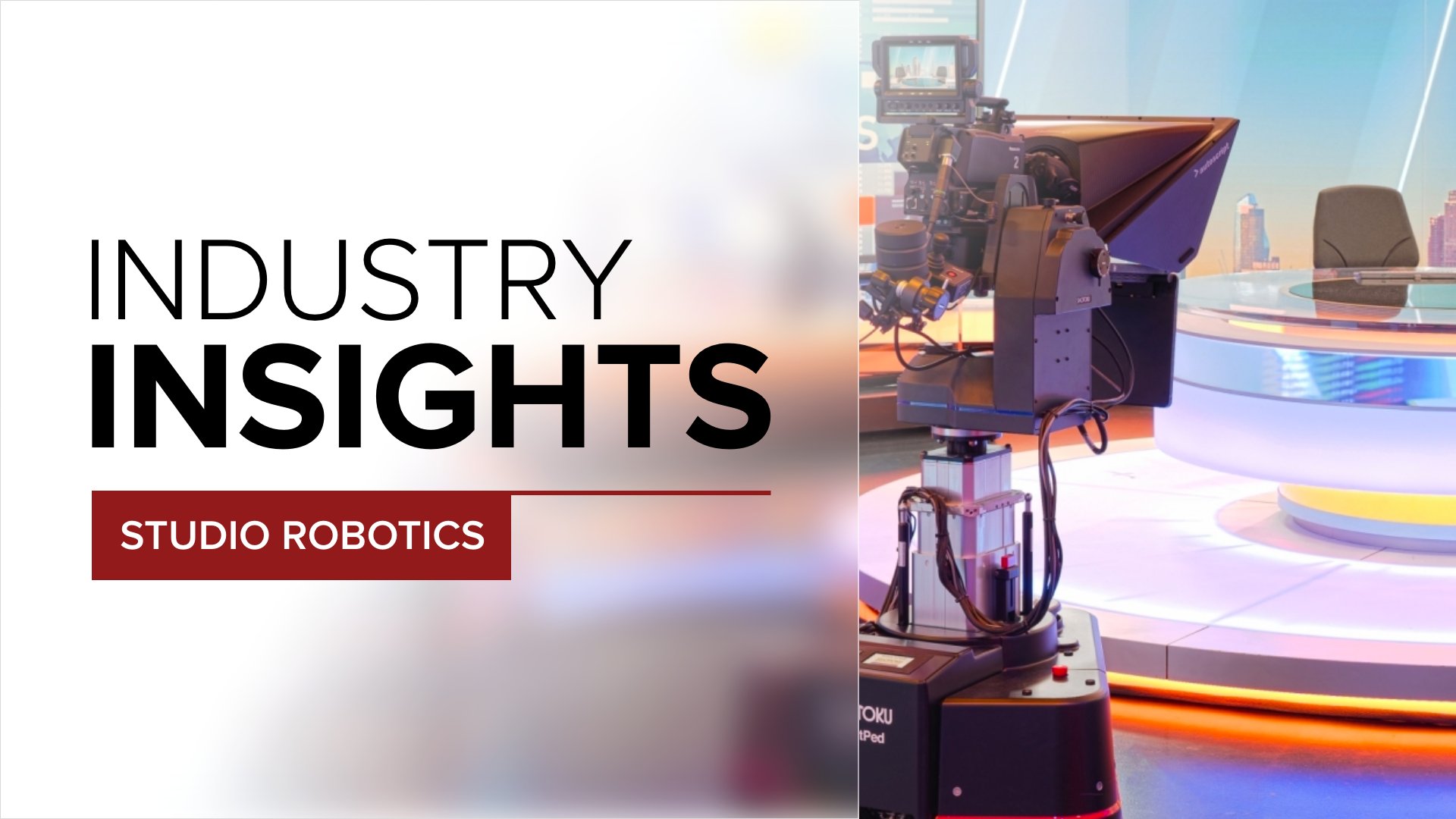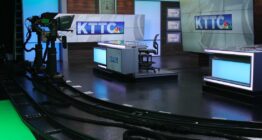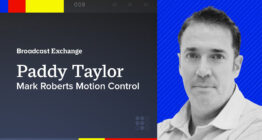Industry Insights: Studio robotics and camera control, part one

Subscribe to NCS for the latest news, project case studies and product announcements in broadcast technology, creative design and engineering delivered to your inbox.
Earlier this year, we spoke to vendors and manufacturers related to studio robotic camera systems.
This Industry Insights roundtable looks at challenges with robotics, workflows and potential drawbacks to robotic camera systems for broadcasters.
The next part in this series will look at camera tracking, another core piece of studio technology that allows creative freedom for virtual production.
What are the biggest challenges to implementing studio robotics today?
Rush Beesley, president, Rushworks: The biggest challenge is controlling cost. Ideally you want your cameras to save and recall motion presets on the pan, tilt and zoom axes as well as move from position to position in the studio. The price of these systems is significant, especially considering the need for prompting systems on each camera.
James Eddershaw, managing director, Shotoku: If the equipment manufacturer listens to and addresses the customer’s goals then implementing studio robotics shouldn’t present too many specific challenges. It’s important to understand why robotics are being used on a particular production and ensure the system configuration chosen is appropriate and capable of meeting the production demands.
Paddy Taylor, head of broadcast, Mark Roberts Motion Control: While studio robotics deliver a wide range of efficiencies, using software solutions to enable shots to be achieved quickly, they do change the dynamic of the production process: from using manual systems that require one-to-one director-to-operator relationships, to needing to think about the shots in advance. This mindset is still new to studio production, and if the software that drives robotic systems isn’t intuitive, then the true benefits won’t be realized.
Michael Cuomo, VP, Telemetrics: The biggest implementation challenge for us has been shifting our commissioning process from an onsite visit to a remote installation. Due to the mechanical nature of our products it has taken quite an effort from our side as well as our customers.
Michael Geissler, CEO, Mo-Sys: Ensuring the robotics control system integrates with the existing production workflow, that it requires the minimum human intervention once set up, and that it is fully encoded and tracked in order to support virtual production.
Jeanette Dahl Torsvik, head of marketing, Electric Friends: In relation to implementing robot control software there is a question of need/cost (both resource and financial cost). In relation to integrating studio robotics in general, we don’t see many challenges other than getting around integration with third party systems.
Karen Walker, VP of camera motion systems, Ross Video: The number of talent positions within each space may actually be increasing. Less space is available for the robots, and there are few areas within the studio that do not appear on air at some point. This makes it more difficult to keep cable looms and the robots themselves out of view of the cameras.
What problems still need to be solved? Workflow or control related?
James Eddershaw: The balance between cost savings through automation while maintaining production flexibility is always delicate. There is no perfect solution but if the system is designed well, it should offer both benefits, if not simultaneously, then with a simple change of operating mode.
Paddy Taylor: Today, the biggest issue to be solved for true remote production is extremely low latency control for robotic cameras. The infrastructure just isn’t up to speed. While low latency connections are becoming commonplace, is that infrastructure already in place between point A and B to allow for true low latency remote robotics control that feels instantaneous to the operator?
Michael Cuomo: Video transport and the latency that comes with it is the biggest issue we still see. Our control system and robotics have very low latency but if there is a delay in the video, it can make remote control difficult.
Karen Walker: Advanced or intelligent automation is only in the early stages when it comes to studio robotics. Today’s robots still rely heavily on human interaction to plan and execute their movements. We’re starting to see AI come into the picture in the form of facial tracking, but this is just the beginning.
Jeanette Dahl Torsvik: There are some technical challenges both network-wise and around IP-video that need to be addressed with different broadcasters. But based on customer feedback and market demand, these have been attended to from our side.
What is the industry not talking about that it should be on this topic?
James Eddershaw: Most key topics are well covered and understood. The balance of full broadcast camera/lens/robotics versus low-cost integrated PTZ solutions is always a hot topic but most broadcasters understand the pros and cons of each.
Paddy Taylor: Sometimes the driver for installing robotics is purely about cost savings, but again, it’s not about replacing people, but more about retargeting staffing. Doing more with less, and allowing staff to focus on the manual tasks, while adding more cameras to increase creativity.
Michael Cuomo: We think there needs to be more discussion around remote support. Being able to support clients remotely is really critical. This includes remote upgrades to software and firmware, and remote logging.
Karen Walker: One important topic is the ability to anticipate unexpected or “unprogrammed” movements of talent and guests. Operators spend time making painstakingly beautiful signature shots that follow the talent for a certain amount of time, but then the talent may do something different, which causes the shots to be poorly framed. It’s mind-blowing that people still don’t consider the ability to correct programmed automated shots on the fly, either on the axes or in time, to be a given. This should be standard on all robotic systems.
Michael Geissler: Distance remote production, and the capability of broadcasters to produce remote events themselves.
Jeanette Dahl Torsvik: Studio robotics and camera control lowers production costs and improves HSE environment. One person can staff four, five, or six cameras. The camera control systems with AI lighten the workload and give more precision in production.
What lessons are you taking away from the pandemic on robotics and control?
Rush Beesley: When operators are not present, robotic systems are. If you design and implement a robotics infrastructure that effectively mimics operator functions, you’re ready for anything. This implies the ability to control a robotics studio from any location with an internet connection.
James Eddershaw: Remote production will continue to be a major driver, even after the pandemic. Systems like ours with inherently distributed architectures work well in that environment so we will always ensure this fundamental design remains at the core.
Paddy Taylor: Our users are starting to realize the benefits of this technology. With the pandemic expediting remote workflows, the use cases for robotics across outside broadcast, studios and even in houses of worship applications are growing, and so is the confidence and understanding in how robotics fit into the bigger picture.
Michael Cuomo: Distributive control has turned out to be a big solution for remotely operating our robotic camera control systems. Instead of having a centralized control room, we can locate our controller anywhere there’s network access. That could be in the same building or even a separate location.
Karen Walker: The pandemic has highlighted the remote-control aspect of robotics, as opposed to the usual focus on automated versus hands-on manual camera operation. This has opened up new markets in a world where physical distancing is a requirement while still allowing traditional applications to continue under new constraints.
Michael Geissler: Remote production, defined either as distance production, or simply robotic control of cameras, is the future of production. The pandemic forced companies to re-think how to minimize crew and talent movement, and from this new remote production techniques and workflows have been created. These will become the new norm going forwards.
Jeanette Dahl Torsvik: During the pandemic there has been more remote programming and production than previously. A higher level of automation has helped to improve the safety of the productions during a challenging time with robotic cameras — less staff in the studio/control room.
Are there any drawbacks of using robotic cameras?
James Eddershaw: Not if the robotics system in use supports both high-performance automated control and the ability to take over manually to adapt to last minute changes as the unforeseen happens, which is always a possibility in a 24/7 live news environment. A simpler robotics system with less flexibility will certainly be limiting in those circumstances.
Paddy Taylor: There are concerns about how robotics may replace people, but that’s really not how we look at it. There is a lack of granularity for camera control across the industry, so the focus should be more on planning the shots and workflows and working out how this can be advantageous, adding to the storytelling, particularly for fast paced applications.
Michael Cuomo: No.
Karen Walker: Robotic cameras don’t have peripheral vision, so following sports or other live events can be challenging, as the systems don’t have the human intuition (yet). Free-roaming robotic cameras can also be difficult, as there may be a need to retarget, remap, and recalibrate to the new location, which takes time. Reliability continues to be a concern when it comes to robotics, as some people are still uncomfortable relying on a machine where in the past there was a human being. However, the risk of failure can be reduced through thoughtful design.
Michael Geissler: Initial cost, but this is quickly recovered in reduced manpower, the ability for one operator to control multiple cameras, and for distance remote production, reduced travel and subsistence costs.
Jeanette Dahl Torsvik: Not in general, but some productions may have problems integrating robotics cameras to pre-existing studio setups. However, if the robotic cameras and rails are incorporated early in studio drawings and set design, it will benefit the production significantly.
Subscribe to NCS for the latest news, project case studies and product announcements in broadcast technology, creative design and engineering delivered to your inbox.









tags
Electric Friends, James Eddershaw, Jeanette Dahl Torsvik, Karen Walker, Michael Cuomo, Michael Geissler, Mo-Sys, MRMC, Paddy Taylor, Robotic Camera Control, robotic cameras, Ross Video, Rush Beesley, Rushworks, Shotoku Broadcast Systems, Telemetrics
categories
Broadcast Equipment, Camera Control & Camera Robotics, Heroes, Industry Insights, Studio Technology, Voices